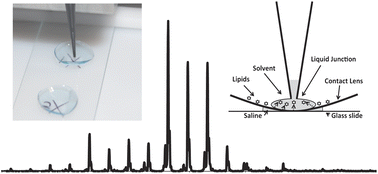Although silicone hydrogel contact lenses have been available since 1999, the accumulation of biological material as solid deposit on the surface of lens polymer during lenses wear is still a reason of discomfort.
With this work, Simon Brown and colleagues from the University of Wollongong, Australia, describe a method to analyse lipids directly from a contact lens using liquid extraction surface analysis coupled to mass spectrometry (LESA-MS/MS). To demonstrate the efficiency of LESA-MS/MS, the researchers analysed the lipids on 25 worn contact lenses and extracted lipids with limited degradation of the lens material in only 15 minutes.
Liquid extraction surface analysis allows the extraction of analytes from a surface by creating a micro-junction between a small volume of solvent at the surface and a pipette tip. The solvent is then aspirated into the pipette tip and infused onto a sensitive mass analyser.
According to the authors, this improved technique will determine the molecular composition of biological deposits and identify the lipid molecular species representing all major classes present in human tear films.
To know more about this study click on the link below.
Communication Automated surface sampling of lipids from worn contact lenses coupled with tandem mass spectrometry
Simon H. J. Brown , Liam H. Huxtable , Mark D. P. Willcox , Stephen J. Blanksby and Todd W. Mitchell
Analyst, 2013, Advance Article
DOI: 10.1039/C2AN36189B











